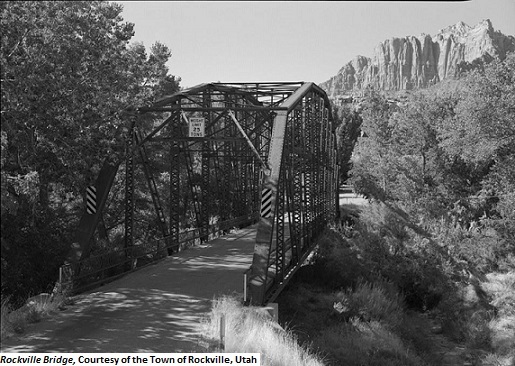Dublin Core
Title
Description
Learn how the 1924 construction of a little bridge in the middle of nowhere put southern Utah’s people to work and opened the region’s scenic wonders to the world.
By 1924, fifteen years after Zion Canyon became a national monument – and later a national park – only a few thousand people had braved Washington County’s grueling rough roads to see the spectacular sight. So when Stephen Mather, then director of the National Park Service, visited in 1923 and offered federal funds to bridge the Virgin River at Rockville, residents were ecstatic. Not only would its construction provide local employment, but the one-lane bridge would open a route connecting five national park areas with numerous small towns.
From the nearest train station in Lund, Utah, sightseers could now be driven in touring cars on a circle from Cedar City to Zion, across the Rockville Bridge – known as the “Rockville Shortcut” – and into the wilds of northern Arizona to Pipe Spring and Grand Canyon’s North Rim. Tourists then turned north to Bryce Canyon and Cedar Breaks, ending again at Lund. One intrepid traveler described the still-unpaved roads of this route as “brick-red, furnace-hot sands,” but the 500-mile journey could now be completed in less than ten days – if the weather held.
Tourists stayed in tent camps or small town inns and ate in local cafes. An increasing number of local folks found employment as cooks and waitresses, drivers, wranglers, park and forest rangers, laborers, freighters, mechanics, bell hops, sales clerks, and later, as shop owners, gas station attendants, grocers, construction workers, and tour guides – all catering to a world seeking the amazement of southern Utah’s wild west.
Although superseded seven years later, in 1931, by the Zion-Mount Carmel Tunnel, the tiny Rockville Bridge kicked off an era of western road-building, national park development, and tourism job growth that were critical to the West’s economy. The Bridge, now nearing its one-hundredth anniversary, also helped meet the Park Service mission of “providing for the enjoyment of future generations” as the world continues to seek southern Utah’s redrock delights.
Creator
Greer Chesher for the Town of Rockville, Utah © 2017
Source
Image: Rockville Bridge. The last surviving Parker Through Truss-type Bridge in Utah. Image courtesy of the Town of Rockville, Utah. You can help with the rehabilitation of the Historic Rockville Bridge – visit http://rockvilleutah.org for more information.
_______________
See Michael Anderson, Zion National Park Roads and Bridges, HAER No. UT-7, National Park Service, 1993, pp. 20-56, Maps pp. 15 and 49; “The Rockville Bridge,” Washington County Historical Society, http://wchsutah.org/roads/rockville-bridge.php, accessed 6/14/2017.

